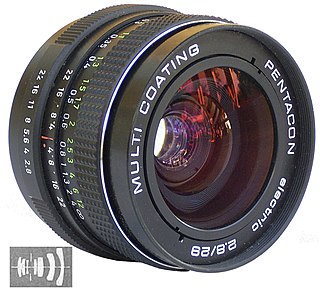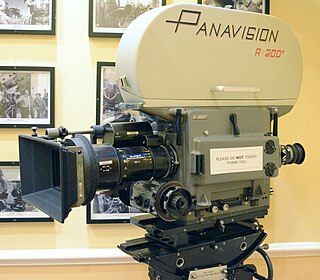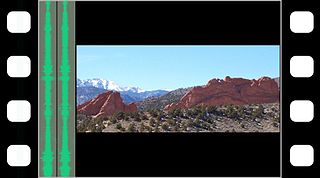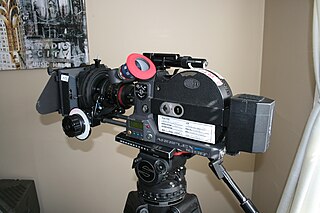
Carl Zeiss AG, branded as ZEISS, is a German manufacturer of optical systems and optoelectronics, founded in Jena, Germany in 1846 by optician Carl Zeiss. Together with Ernst Abbe and Otto Schott he laid the foundation for today's multi-national company. The current company emerged from a reunification of Carl Zeiss companies in East and West Germany with a consolidation phase in the 1990s. ZEISS is active in four business segments with approximately equal revenue in almost 50 countries, has 30 production sites and around 25 development sites worldwide.
Negative pulldown is the manner in which an image is exposed on a film stock, described by the number of film perforations spanned by an individual frame. It can also describe whether the image captured on the negative is oriented horizontally or vertically. Changing the number of exposed perforations allows a cinematographer to change both the aspect ratio of the image and the size of the area on the film stock that the image occupies.

In film and photography, a prime lens is a fixed focal length photographic lens, typically with a maximum aperture from f2.8 to f1.2. The term can also mean the primary lens in a combination lens system. Confusion between these two meanings can occur without clarifying context. Alternate terms, such as primary focal length, fixed focal length, or FFL are sometimes used to avoid ambiguity.

Panavision is an American motion picture equipment company founded in 1953 specializing in cameras and lenses, based in Woodland Hills, California. Formed by Robert Gottschalk as a small partnership to create anamorphic projection lenses during the widescreen boom in the 1950s, Panavision expanded its product lines to meet the demands of modern filmmakers. The company introduced its first products in 1954. Originally a provider of CinemaScope accessories, the company's line of anamorphic widescreen lenses soon became the industry leader. In 1972, Panavision helped revolutionize filmmaking with the lightweight Panaflex 35 mm movie camera. The company has introduced other cameras such as the Millennium XL (1999) and the digital video Genesis (2004).

Schneider Kreuznach is the abbreviated name of the company Jos. Schneider Optische Werke GmbH, which is sometimes also simply referred to as Schneider. They are a manufacturer of industrial and photographic optics. The company was founded on 18 January 1913 by Joseph Schneider as Optische Anstalt Jos. Schneider & Co. at Bad Kreuznach in Germany. The company changed its name to Jos. Schneider & Co., Optische Werke, Kreuznach in 1922, and to the current Jos. Schneider Optische Werke GmbH in 1998.

Arri Group is a German manufacturer of motion picture film equipment. Based in Munich, the company was founded in 1917. It produces professional motion picture cameras, lenses, lighting and post-production equipment. It is cited by Hermann Simon as an example of a "hidden champion". The Arri Alexa camera system was used to shoot several films that won the Academy Award for Best Cinematography, including Hugo (2011), Life of Pi (2012), Gravity (2013), Birdman (2014), The Revenant (2015) and 1917 (2019).

Techniscope or 2-perf is a 35 mm motion picture camera film format introduced by Technicolor Italia in 1960. The Techniscope format uses a two film-perforation negative pulldown per frame, instead of the standard four-perforation frame usually exposed in 35 mm film photography. Techniscope's 2.33:1 aspect ratio is easily enlarged to the 2.39:1 widescreen ratio, because it uses half the amount of 35 mm film stock and standard spherical lenses. Thus, Techniscope release prints are made by anamorphosing, enlarging each frame vertically by a factor of two.
The Arriflex D-20 is a film-style digital motion picture camera made by Arri first introduced in November 2005. The camera's attributes are its optical viewfinder, modularity, and 35mm-width CMOS sensor. The camera was discontinued in 2008 when its successor, the Arriflex D-21, was introduced.

A camera magazine is a light-tight chamber or pair of chambers designed to hold film and move motion picture film stock before and after it has been exposed in the camera. In most movie cameras, the magazine is a removable piece of equipment. Many still photo cameras also have removable camera magazines. A film cartridge serves the same function, but is usually not reusable.
BNCR is a lens mount developed by Mitchell for use with its reflex 35 mm movie cameras. It was an update of the BNC mount done to accommodate the reflex viewer in the later cameras. BNC mount lenses cannot be used in reflex Mitchell cameras as their shorter back-focus will hit and damage the reflex viewer, which, in various versions, was a pellicle mirror or a rotating mirror. The initials stand for Blimped Newsreel Camera Reflex, which meant that it is a 35 mm camera originally intended for news reporting but included a blimp housing for sound stage shooting plus a reflex viewer to allow the camera operator to view the action through the lens while filming. The reflex option was only added in 1967, while the blimp option - thereby converting an NC into a BNC, - was available at the camera's introduction in 1934, but only a few BNC examples were made before the onset of WW-II, during which manufacture of "production" cameras was suspended.
The Arriflex 435 is a movie camera product line created by Arri in 1995 to replace the Arriflex 35-III line. The number reflects its position as a successor camera to the Arri III and the fact that it is designed for 35 mm film. The 435 cameras are specifically designed as MOS cameras, which means that they are conventionally considered to be too loud to record usable location sound. However, this also frees the camera up to be optimized for non-sync sound uses, particularly any filming which either doesn't require sound or shooting at non-sync speed, shooting in reverse, or ramping between different speeds. As such, its potential applications are widespread, and thus it is regularly used on music videos, commercials, second unit work on features, special effects work, and motion control, among other usage. Rival Panavision even owns more 435s for rental than Arri's own hire houses; Panavisions, however, can be converted to Pan-Arri 435s where they are modified to accept Panavision lenses and accessories. In recognition of the achievements of the 435 system, AMPAS awarded Arri a Scientific and Engineering Academy Award in 1999.
Arricam is a 35 mm movie camera line manufactured by Arri.
This article summarized the comparison of movie cameras.

Anamorphic format is the cinematography technique of shooting a widescreen picture on standard 35 mm film or other visual recording media with a non-widescreen native aspect ratio. It also refers to the projection format in which a distorted image is "stretched" by an anamorphic projection lens to recreate the original aspect ratio on the viewing screen. The word anamorphic and its derivatives stem from the Greek anamorphoo, compound of morphé with the prefix aná. In the late 1990s and 2000s, anamorphic lost popularity in comparison to "flat" formats such as Super 35 with the advent of digital intermediates; however, in the years since digital cinema cameras and projectors have become commonplace, anamorphic has experienced a considerable resurgence of popularity, due in large part to the higher base ISO sensitivity of digital sensors, which facilitates shooting at smaller apertures.

The Arriflex 535 is a movie camera product line created by Arri in 1990 to replace the Arriflex 35 BL line.
Moviecam Compact is a movie camera product line created by Moviecam in 1990. It was developed by Fritz Gabriel Bauer as an improvement on his Moviecam SuperAmerica.

The Arriflex 16SR is a motion picture camera product line created by Arri, introduced in 1975. This 16SR camera series is designed for 16 mm filmmaking in Standard 16 format. 'SR' Stands for Silent Reflex.
Articles related to the field of motion pictures include:

The Arri Alexa is a digital motion picture camera system developed by Arri. First introduced in April 2010, the camera was Arri's first major transition into digital cinematography after previous efforts such as the Arriflex D-20 and D-21.

The Canon Cinema EOS autofocus digital photographic and cinematographic SLR and mirrorless interchangeable lens camera system was introduced in late 2011 with the Canon EOS C300 and followed by the Canon EOS C500 and Canon EOS 1D C in early 2012.











